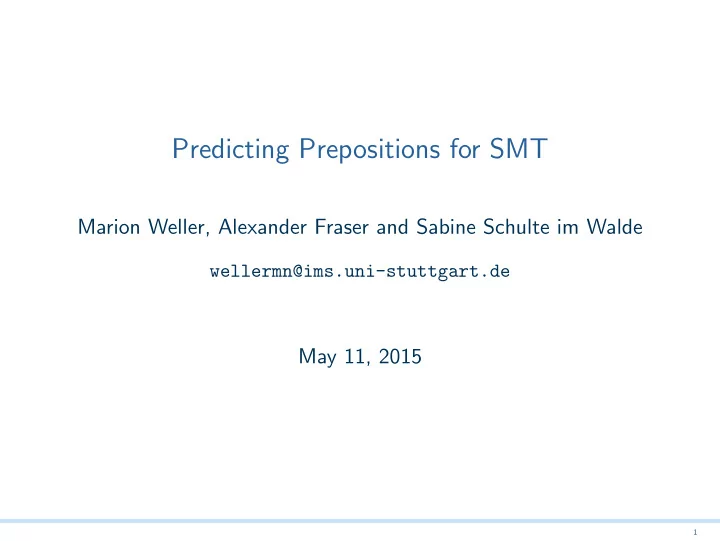

Predicting Prepositions for SMT Marion Weller, Alexander Fraser and Sabine Schulte im Walde wellermn@ims.uni-stuttgart.de May 11, 2015 1
Introduction Translating prepositions is difficult in SMT • Convey the source-side meaning • Meet target-side requirements 2
Introduction Translating prepositions is difficult in SMT • Convey the source-side meaning • Meet target-side requirements How are prepositions generated in translation? 2
Introduction Translating prepositions is difficult in SMT • Convey the source-side meaning • Meet target-side requirements How are prepositions generated in translation? • Functional prepositions : determined by target-side requirements to believe in sth. an etw. glauben → 2
Introduction Translating prepositions is difficult in SMT • Convey the source-side meaning • Meet target-side requirements How are prepositions generated in translation? • Functional prepositions : determined by target-side requirements to believe in sth. an etw. glauben → • Content-bearing prepositions : largely determined by source-side preposition to sit under / on the table → unter / auf dem Tisch sitzen 2
Introduction Translating prepositions is difficult in SMT • Convey the source-side meaning • Meet target-side requirements How are prepositions generated in translation? • Functional prepositions : determined by target-side requirements to believe in sth. an etw. glauben → • Content-bearing prepositions : largely determined by source-side preposition to sit under / on the table → unter / auf dem Tisch sitzen • “In-between” : source- and target-side play a role go to the cinema/ to the beach → ins Kino/ an den Strand gehen 2
Generating prepositions on the target-side Objective: Model all subcategorized elements (PP/subject/object) 3
Generating prepositions on the target-side Objective: Model all subcategorized elements (PP/subject/object) Abstract representation in a morphology-aware SMT system • Prepositions are substituted with place-holders • All subcategorized elements are available in an abstract form 3
Generating prepositions on the target-side Objective: Model all subcategorized elements (PP/subject/object) Abstract representation in a morphology-aware SMT system • Prepositions are substituted with place-holders • All subcategorized elements are available in an abstract form Generation of prepositions as post-processing step based on a combination of source- and target-side information 3
Generating prepositions on the target-side Objective: Model all subcategorized elements (PP/subject/object) Abstract representation in a morphology-aware SMT system • Prepositions are substituted with place-holders • All subcategorized elements are available in an abstract form Generation of prepositions as post-processing step based on a combination of source- and target-side information • Arguments are assigned their respective function overt preposition → PP empty preposition → NP • Arguments are then inflected accordingly 3
Generating prepositions on the target-side Objective: Model all subcategorized elements (PP/subject/object) Abstract representation in a morphology-aware SMT system • Prepositions are substituted with place-holders • All subcategorized elements are available in an abstract form Generation of prepositions as post-processing step based on a combination of source- and target-side information • Arguments are assigned their respective function overt preposition → PP empty preposition → NP • Arguments are then inflected accordingly • Realization of prepositions is independent of structural mismatches to pay attention to sth. → auf etw. achten ∅ etw. beachten 3
Overview of the morphology-aware translation process input lemmatized SMT output prep morph. feat. inflected gloss ∅ − → ∅ -Acc – PREP what welch<PWAT> Acc Acc.Fem.Sg.Wk welche which role Rolle<+NN><Fem><Sg> Acc Acc.Fem.Sg.Wk Rolle role ∅ − → ∅ -Nom PREP – the die<+ART><Def> Nom Nom.Masc.Sg.St der the giant Nom Nom.Masc.Sg.Wk riesige giant riesig<ADJ> planet Nom Nom.Masc.Sg.Wk Planet planet Planet<+NN><Masc><Sg> has – – gespielt played gespielt<VVPP> played – – hat has hat<VAFIN> − → in PREP bei-Dat – bei for the die<+ART><Def> Dat Dat.Fem.Sg.St der the development Entwicklung<+NN><Fem><Sg> Dat Dat.Fem.Sg.Wk Entwicklung development of − → PREP ∅ -Gen – the Gen Gen.Neut.Sg.St des of-the die<+ART><Def> solar system Gen Gen.Neut.Sg.Wk Sonnensystems solar system Sonnensystem<+NN><Neut><Sg> 4
Outcome and Discussion • Basic place-holder representation → negative impact on translation quality 5
Outcome and Discussion • Basic place-holder representation → negative impact on translation quality • Experiments with enriched place-holder representation – annotation of grammatical case – annotation of governing verb/noun – annotation of subcategorization status 5
Outcome and Discussion • Basic place-holder representation → negative impact on translation quality • Experiments with enriched place-holder representation – annotation of grammatical case ⇐ best system – annotation of governing verb/noun – annotation of subcategorization status 5
Outcome and Discussion • Basic place-holder representation → negative impact on translation quality • Experiments with enriched place-holder representation – annotation of grammatical case ⇐ best system – annotation of governing verb/noun – annotation of subcategorization status • No improvement over the morphology-aware baseline (BLEU and evaluation of preposition accuracy) 5
Outcome and Discussion • Basic place-holder representation → negative impact on translation quality • Experiments with enriched place-holder representation – annotation of grammatical case ⇐ best system – annotation of governing verb/noun – annotation of subcategorization status • No improvement over the morphology-aware baseline (BLEU and evaluation of preposition accuracy) • How to improve the current system? 5
Outcome and Discussion • Basic place-holder representation → negative impact on translation quality • Experiments with enriched place-holder representation – annotation of grammatical case ⇐ best system – annotation of governing verb/noun – annotation of subcategorization status • No improvement over the morphology-aware baseline (BLEU and evaluation of preposition accuracy) • How to improve the current system? Abstract representation – case: light semantic annotation – more semantically motivated information to obtain a more meaningful representation of prepositions 5
Thank you! 6
Recommend
More recommend